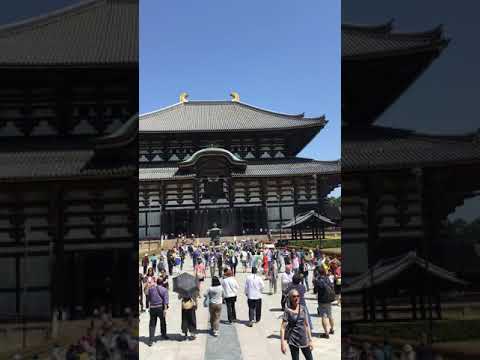Eric Clark’s Travel Videos – Osaka Japan – Todaiji Temple Oldest Wooden Structure in the World
My name is Eric Clark and I am a world traveler. I have been around the world a few times and decided to help fund my travels by sharing my videos and pictures. I have been to almost every country and would be glad to give tips and pointers. Drop me a note. = )
From Wikipedia
“Tōdai-ji (東大寺, Eastern Great Temple)[1] is a Buddhist temple complex that was once one of the powerful Seven Great Temples, located in the city of Nara, Japan. Its Great Buddha Hall (大仏殿 Daibutsuden) houses the world’s largest bronze statue of the Buddha Vairocana, known in Japanese as Daibutsu (大仏). The temple also serves as the Japanese headquarters of the Kegon school of Buddhism. The temple is a listed UNESCO World Heritage Site as one of the “Historic Monuments of Ancient Nara”, together with seven other sites including temples, shrines and places in the city of Nara. Deer, regarded as messengers of the gods in the Shinto religion, roam the grounds freely.
The beginning of building a temple where the Kinshōsen-ji complex sits today can be dated to 728, when Emperor Shōmu established Kinshōsen-ji (金鐘山寺) as an appeasement for Prince Motoi (ja:基王), his first son with his Fujiwara clan consort Kōmyōshi. Prince Motoi died a year after his birth.
During the Tenpyō era, Japan suffered from a series of disasters and epidemics. It was after experiencing these problems that Emperor Shōmu issued an edict in 741 to promote the construction of provincial temples throughout the nation. Tōdai-ji (still Kinshōsen-ji at the time) was appointed as the provincial temple of Yamato Province and the head of all the provincial temples. With the alleged coup d’état by Nagaya in 729, a major outbreak of smallpox around 735–737, worsened by consecutive years of poor crops, then followed by a rebellion led by Fujiwara no Hirotsugu in 740, the country was in a chaotic situation. Emperor Shōmu had been forced to move the capital four times, indicating the level of instability during this period.
Role in early Japanese Buddhism[edit]
The original main hall was much larger than its successor structure
According to legend, the monk Gyoki went to Ise Grand Shrine to reconcile Shinto with Buddhism, spending seven days and nights reciting sutras until the oracle declared Vairocana Buddha compatible with worship of the sun goddess Amaterasu.
Under the Ritsuryō system of government in the Nara Period, Buddhism was heavily regulated by the state through the Sōgō (僧綱, Office of Priestly Affairs). During this time, Tōdai-ji served as the central administrative temple for the provincial temples for the six Buddhist schools in Japan at the time: the Hossō, Kegon, Jōjitsu, Sanron, Ritsu and Kusha. Letters dating from this time also show that all six Buddhist schools had offices at Tōdai-ji, complete with administrators, shrines and their own library.
The Great South Gate (nandaimon), a National Treasure (13th century)
Japanese Buddhism during this time still maintained the lineage of the Vinaya and all officially licensed monks had to take their ordination under the Vinaya at Tōdai-ji. In 754, ordination was given by Ganjin, who arrived in Japan after overcoming hardships over 12 years and six attempts of crossing the sea from China, to Empress Kōken, former Emperor Shōmu and others. Later Buddhist monks, including Kūkai and Saichō took their ordination here as well.[10] During Kūkai’s administration of the Sōgō, additional ordination ceremonies were added to Tōdai-ji, including ordination of the Bodhisattva Precepts from the Brahma Net Sutra and the esoteric Precepts, or Samaya, from Kukai’s own newly established Shingon school of Buddhism. Kūkai added an Abhiseka Hall for the use of initiating monks of the six Nara schools into the esoteric teachings.
by 829.
During its height of power, Tōdai-ji’s famous Shuni-e ceremony was established by the monk Jitchū, and continues to this day. ”


AloJapan.com